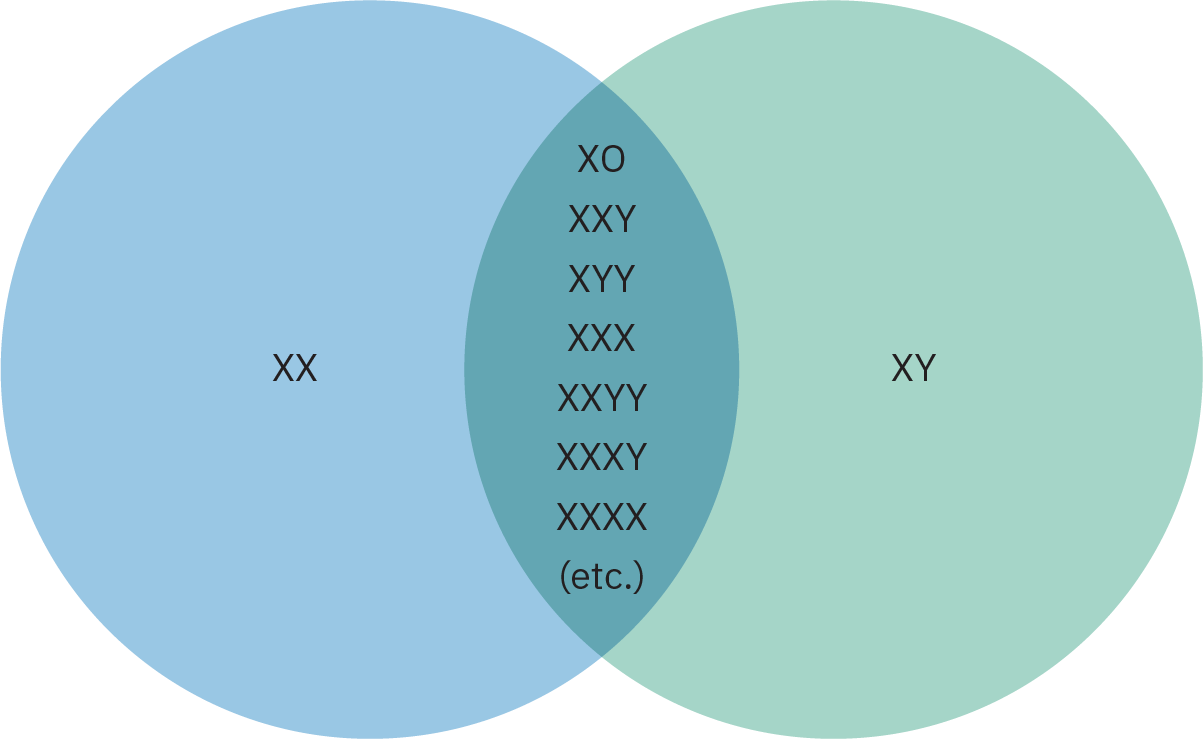Table of Contents |
When filling out a document such as a job application or school registration form, you are often asked to provide your name, address, phone number, birth date, and sex or gender. But have you ever been asked to provide your sex and your gender? Like many people, you may not have realized that sex and gender are not the same.
The term sex refers to physical or physiological differences between males and females, including both primary sex characteristics (the reproductive structures) and secondary characteristics (such as height and muscularity). However, gender refers to behaviors, personal traits, and social positions that society attributes to being female or male.
The sex of a person is determined by an examination of biological and anatomical features, including (but not limited to): visible genitalia (e.g., penis, testes, vagina), internal sex organs (e.g., ovaries, uterus), secondary sex characteristics (e.g., breasts, facial hair), chromosomes (XX for females, XY for males, and other possibilities), reproductive capabilities (including menstruation), and the activities of growth hormones, particularly testosterone and estrogen.
A person’s sex, as determined by their biology, does not always correspond with their gender. Therefore, the terms sex and gender are not interchangeable.
A baby who is born with male genitalia will most likely be identified as male. As a child or adult, however, they may identify with the feminine aspects of culture. Since the term sex refers to biological or physical distinctions, characteristics of sex will not vary significantly between different human societies. Generally, persons of the female sex, regardless of culture, will eventually menstruate and develop breasts that can lactate.
The dichotomous or binary view of gender (the notion that someone is either male or female) is specific to certain cultures and is not universal. In some cultures, gender is viewed as fluid. In the past, some anthropologists used the term berdache to refer to individuals who occasionally or permanently dressed and lived as a different gender. The practice has been noted among certain Native American tribes (Jacobs, Thomas, and Lang 1997). Samoan culture accepts what Samoans refer to as a “third gender.”
It may seem as though nature divides humans neatly into females and males, but such a long list of distinguishing factors results in a great deal of ambiguity and diversity within categories. For instance, hormonal influences can produce results different from the ways that people typically develop. Hormonal influences shape the development of sex organs over time and can stimulate the emergence of secondary sex characteristics associated with the other sex. Clothes on or clothes off, people can have body features associated with one sex category and chromosomes associated with another.
Intersex is a general term used to describe people whose sex traits, reproductive anatomy, hormones, or chromosomes are different from the usual two ways human bodies develop. There are many causal factors that can make a person intersex. Genetically, the baby may have a different number of sex chromosomes. Rather than two X chromosomes (associated with females) or one X and one Y chromosome (associated with males), babies are sometimes born with an alternative number of sex chromosomes, such as XO (only one chromosome) or XXY (three chromosomes). In other cases, hormonal activity or even chance occurrences in the womb can affect the baby’s anatomy. Some intersex traits are recognized at birth, but others are not recognizable until puberty or later in life (interACT 2021).

While some intersex people have physically recognizable features that are described by specific medical terms, intersex people and newborns are usually healthy. Most in the medical and intersex communities reject unnecessary surgeries intended to make a baby conform to a specific gender assignment; medical ethicists indicate that any surgery to alter intersex characteristics or traits—if desired—should be delayed until an individual can decide for themselves (Behrens 2021). If a physical trait or medical condition prohibits a baby from urinating or performing another bodily function (which is very rare), then a medical procedure such as surgery will be needed; in other cases, hormonal issues related to intersex characteristics may require medical intervention.
Transgender people's sex assigned at birth and their gender identity are not necessarily the same. A transgender woman is a person who was assigned male at birth but who identifies and/or lives as a woman; a transgender man was assigned female at birth but lives as a man. While determining the size of the transgender population is difficult, it is estimated that 1.4 million adults (Herman 2016) and 2% of high school students in the U.S. identify as transgender (Johns 2019).
The term "transgender" does not indicate sexual orientation, and assumptions cannot be made about people's sexual orientation based on knowledge about their gender identity (GLAAD 2021).
Intersex and transgender are not interchangeable terms; many transgender people have no intersex traits, and many intersex people do not consider themselves transgender.
Those who identify with the sex they were assigned at birth are sometimes referred to as cisgender, utilizing the Latin prefix cis, which means "on the same side." (The prefix trans means "across"). As with transgender people, the term or usage of cisgender does not indicate a person's sexual orientation or gender expression. Agender people do not identify with any gender.
SOURCE: THIS TUTORIAL HAS BEEN ADAPTED FROM (1) OPENSTAX “INTRODUCTION TO SOCIOLOGY 3E”. ACCESS FOR FREE AT OPENSTAX.ORG/BOOKS/INTRODUCTION-SOCIOLOGY-3E/PAGES/1-INTRODUCTION. (2) OPENSTAX “INTRODUCTION TO ANTHROPOLOGY”. ACCESS FOR FREE AT OPENSTAX.ORG/BOOKS/INTRODUCTION-ANTHROPOLOGY/PAGES/1-INTRODUCTION. LICENSING (1 & 2): CREATIVE COMMONS ATTRIBUTION 4.0 INTERNATIONAL.